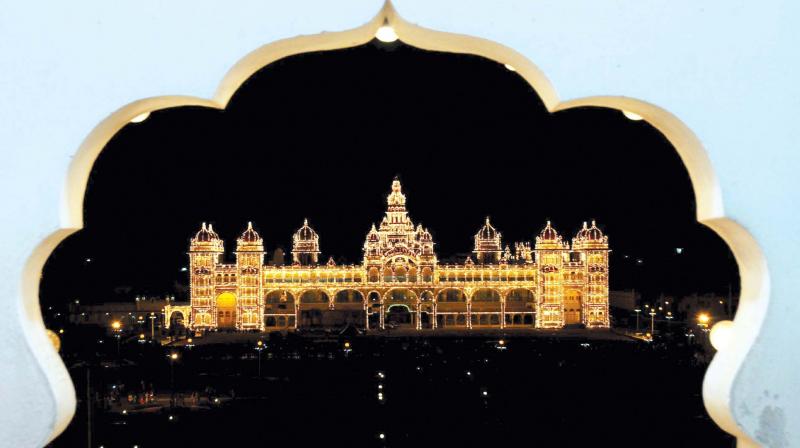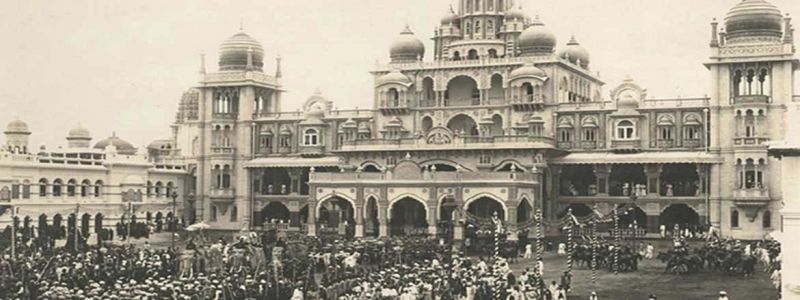Mysuru’s lament: Bring back my Dasara of yore!

In the post-Independence era after the princely states passed into history, the mantle passed to the Karnataka government which decided to hold the Dasara festival and organise the grand Jumbo Savari on Vijayadashami day to showcase the might of the armed forces, the state’s rich heritage and also provide a cultural feast to citizens. But over the years, the festival has petered out into a mere ritual making many Mysureans long for the good old days when tradition and royalty took centre stage with people’s participation adding a democratic touch to the festivities.
“Where is my good old Dasara which used to be of the people, for the people and by the people? More than anything else, it has become a ritualistic affair by the political force in power to gain mileage”, bemoans Ms Kamalamma, a nonagenarian who has seen Dasara during the days of the Maharajas.
The contours of the ‘Naada Habba’ have no doubt changed. The royal family which had a say in Dasara preparations till the 1980s, was kept out of the loop by subsequent governments. The ritual of extending a formal invitation to the royals by giving them a purse just days before the Dasara festival, however continues like ever. Officials even take the help of royal family members to tie the 800 kg golden howdah on the back of the main elephant before the Dasara procession begins. The golden howdah continues to be in the custody of the royal family and is provided for the festivities on the day of the procession to keep the idol of Goddess Chamudeshwari-the presiding deity of the Mysuru kingdom in it.

The titular king of the erstwhile Wadiyar dynasty is also invited to the podium to shower flowers on the howdah carrying elephant, along with the chief guests. The participation of the royals ends here and they are not consulted on ways and means to make Dasara more attractive without compromising on the rich tradition.
Till the 1990s, Dasara festivities including the cultural extravaganza were restricted to the palace premises with the famed flower show happening at Curzon park. The scene has now entirely changed with the cultural programmes held at six to eight venues with the fare on offer including Yuva Dasara, Mahila Dasara, Makkala Dasara, Raitha Dasara, Yoga Dasara and Open Street Festival. Over a dozen committees have been formed to accommodate workers of the party at the helm of affairs but what about citizen participation? Why keep the original Mysurean out of the process of selection of artists of national and international repute for the musical and dance performances?
What is also disconcerting is that there is hardly an audience for the cultural events at the palace premises and no different is the story when it comes to the other programme venues. Ironically, there have been situations when the artistes outnumbered the audience at many places. This is nothing short of an insult to those of state or national stature who make painstaking efforts to come up with their best show on the day that matters.
An officer on the condition of anonymity said that the mess could be because some members of the cultural committee who play a crucial role in the selection of programmes and artistes, do not know much about the arts and music but cannot stop themselves from interfering in the selection!
A sense of lethargy has also crept in compared to the days of the Maharajas when preparations for the following year’s Dasara used to begin from the day after the Jumbo Savari. Every paisa spent on the festival was then accounted for and the final balance sheet approved by the ruler. Now, there are no checks and balances and nobody has a clear picture of who maintain details of expenditure, say sources .
The routine now is that the preparations for the celebration start just a month before the festival with city officials getting into a never seen frenzy to get Mysuru’s roads asphalted. Artistes are informed about their performances just three to four days before their events which shows how little bureaucrats know or care about the world of art and culture.
In contrast, in the olden days, citizens of Mysuru used to celebrate the festival on their own by holding ‘bombe pooja’ and special rituals on all ten days of the festival and more importantly, illuminating their houses with oil lamps (diyas). The streets and important city circles are now illuminated on all ten days but people’s participation is a shadow of what it used to be with everything managed by the government and officials.
Another point of concern is that the festivities have been blatantly commercialised as the government is not too keen on shelling out too much for the events. So Dasara in its current from resembles a mega event, sponsored and hosted by the state with the rich culture of Mysuru taking a back seat.
The festival now serves as a platform for elected representatives and officials to showcase themselves more than the greatness of Karnataka and its history. Citizens seem to have given up after making repeated pleas to the authorities with public involvement a far cry from what it used to be.
That something has gone terribly wrong with the manner in which the festival is organised becomes evident when in the name of promoting Dasara, officials go abroad to attract foreign tourists hardly realising that they (tourists) know more about the festival than any bureaucrat!
Is it time we took a fresh look at the centuries old festival and the kind of promotion it requires? Has the time arrived to free Dasara from the clutches of insensitive babus and make it a truly people’s festival? Mysuru’s cultural aficionados are worried and are waiting for an answer hoping that it won’t be too late.

